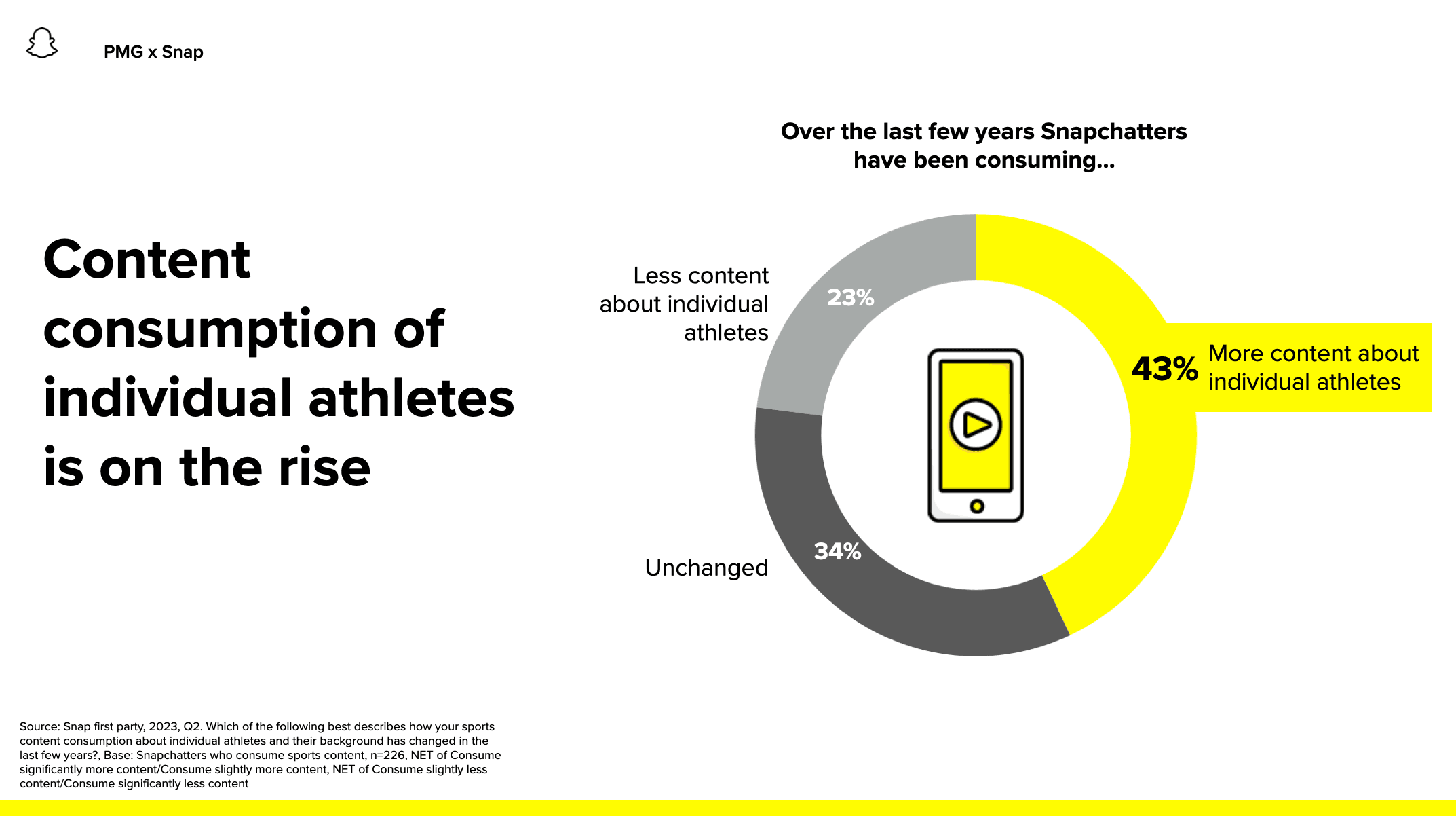Accessibility Tools
PMG Digital Made for Humans
The Growing Influence & Relatability of Individual Athletes
April 1, 2024 | 4 min read
Shelina Taki, Executive Strategy Director
Shelina has spent the last 17+ years helping brands find their way into the hearts and minds of the people they want to reach. Her proven approach to brand strategy comes to life at the intersection of data and culture. Shelina has worked with some of the world’s most beloved brands, including Google, Toyota, Apple, Starbucks, BMW, Postmates, Expedia, and MARS Wrigley, driving business impact and cultural connection. At PMG, Shelina leads the brand planning and creative strategy disciplines across our portfolio.
Until recent history, a handful of names at any given time dominated the conversation around a sport. Wayne Gretzky in hockey, Michael Jordan in basketball, and Babe Ruth in baseball, to name a few. Aside from these greats, however, until recently, much of the conversation regarding sports was about teams and their trajectory. Whether that was the plight of the underdog, a big rivalry, or a dynasty in the making. In recent years, there's been a slow and steady shift, with more attention now being paid to the stories of individual athletes rather than the teams they occupy, which in turn brings new opportunities for marketers looking to diversify and engage with new audiences.
Within the realms of social media and creator content (ranging from podcasts to short-form videos), fans now have a near-unlimited supply of athlete content and stories to indulge in. The resulting intake of content makes fans feel like they have personal access to the private lives of their favorite players, creating a sense of connection to the athlete and a feeling of community within the fandom, and an increasing number of fans investing time and energy into the journey of individual athletes, rather than overall teams, as used to be the norm.
PMG recently partnered with Snapchat to run an on-platform survey among 439 U.S. Snapchatters (13-49 YO) to better understand their consumption patterns when it comes to sports. We found that the number of Snapchatters who enjoy consuming live or recorded matches (28%) is nearly equivalent to that of Snapchatters who enjoy consuming sports content on social media (27%). Fans are just as interested in the narrative and discussion surrounding the sport as the game itself.
Our research with Snap found that 43% of Snapchatters state their consumption of content around individual athletes has been on the rise over the past few years.
Additionally, 43% of Snapchatters who consume sports content, state their consumption of content around individual athletes has been on the rise over the past few years. The connection formed between individual athletes and fans can bolster teams and franchises and, at times, even an entire league or sport. This has been the case with the rapid rise in popularity of Major League Soccer (MLS) since global superstar Lionel Messi arrived in Miami. His presence in MLS led the number of subscribers to MLS Season Pass on Apple TV to more than double, and Spanish language viewership on MLS Season Pass surpassed over 50% for Messi matches.

We’ve also seen a rise in the popularity of a sport based on the personal story of a given athlete, such as the case of Simone Biles, prompting an increased interest in gymnastics as she became more vocal about her perspectives on well-being within competitive sports.
The same is true for Naomi Osaka and her journey within tennis. In both cases, fans who weren't previously engaged with gymnastics or tennis now had a vested interest in these athletes’ stories and their respective sports. This is in line with our research showing that 45% of Snaphatters agree that content about players’ personal stories has made them more invested in the players and the sports they play. Mike Tyson is a standout example of an athlete and creator who’s leveraging the power of personal storytelling on Snapchat to draw closer to his fans. From sharing his latest workouts to unfiltered glimpses into his day-to-day life outside the boxing ring, Tyson’s authenticity has captivated Snapchatters around the world, with him amassing 1.6 million followers in just eight months on the platform.
"On and off-platform, Snapchat enhances the way fans watch, experience, and celebrate sports by bringing them closer to the teams, leagues, and athletes they love,” said Anmol Malhotra, Head of Sports and Media Partnerships at Snap. “And just as Snapchatters continue to turn to the platform to foster real-world relationships, they are also deepening their relationship as fans of their favorite athletes, celebrities, and sports creators through unique, behind-the-scenes content you won't find anywhere else."
When it comes to the origins of sports fandom, the top reason stated among those surveyed was hometown or geographic loyalty (49%). Thirty-six percent say they support based on team performance, while 33% support a team because of a specific player, indicating the significant opportunity that exists behind powerful athletic voices.
For marketers looking to reach specific audiences, it may be just as effective, if not more, to partner with individual athletes versus entire teams, even if those athletes are not global superstars. The opportunity for connection with less famous athletes is still strong because of their powerful fandoms. With NIL restrictions being alleviated, we are now seeing athletes in more obscure sports getting endorsement deals because they are relevant to their school’s culture and fandom. In fact, athletes who have less traditional backgrounds than others in their given sport offer a lot of potential for brands looking to authentically connect with new audiences.
Diversity continues to dominate conversations around individual athletes, with a lot of attention being paid to the impact of learning about the ethnic, cultural, religious, and socioeconomic backgrounds surrounding different players. These shared stories and surrounding conversations provide another means of authentic connection between athletes and fans and help propagate IRL conversations around diversity. Forty-five percent of Snapchatters believe that diverse representation of athletes in sports promotes more open discussions about diversity in life.
For example, Lewis Hamilton’s recent rise to the top of Formula 1 has brought to the forefront the lack of diversity in the sport, as Hamilton is the only Black driver in the league. Hamilton himself has stated that increasing diversity in F1 remains one of his priorities as he transitions to Ferrari this year. Hamilton’s trajectory has opened the door for other aspiring F1 drivers to find a place for themselves in a sport where they hadn't previously felt included.
Beyond creator content, we continue to see a surge in high-end productions sponsored by streaming giants that focus on the individual stories of athletes. Since Michael Jordan’s The Last Dance reached peak popularity in 2020, Netflix has released multiple series, zoning in on different sports, including Formula 1 with Drive to Survive, Break Point (tennis), Captains of the World (soccer), and others. Apple TV has also invested in athlete stories with a documentary about Yankees great Derek Jeter and a recently released mini-series about Lionel Messi, among others.
As the stories of individual athletes continue to play an increasingly large role in the hearts and minds of their fans, both sports-related and otherwise, it presents an important opportunity for sports leagues, franchises, and even individual brands to understand the nuances of different fandoms and cultures, in order to best connect with potential new audiences via a new and passion-fueled vehicle for resonance.
Source: Exploring Evolving Sports Engagement on Snapchat, conducted through Snapchat’s on-platform market research tool in partnership with PMG, November 2023, Base: U.S. Snapchatters, n=439, U.S. Snapchatters who consume sports content, n=226 to n=182
